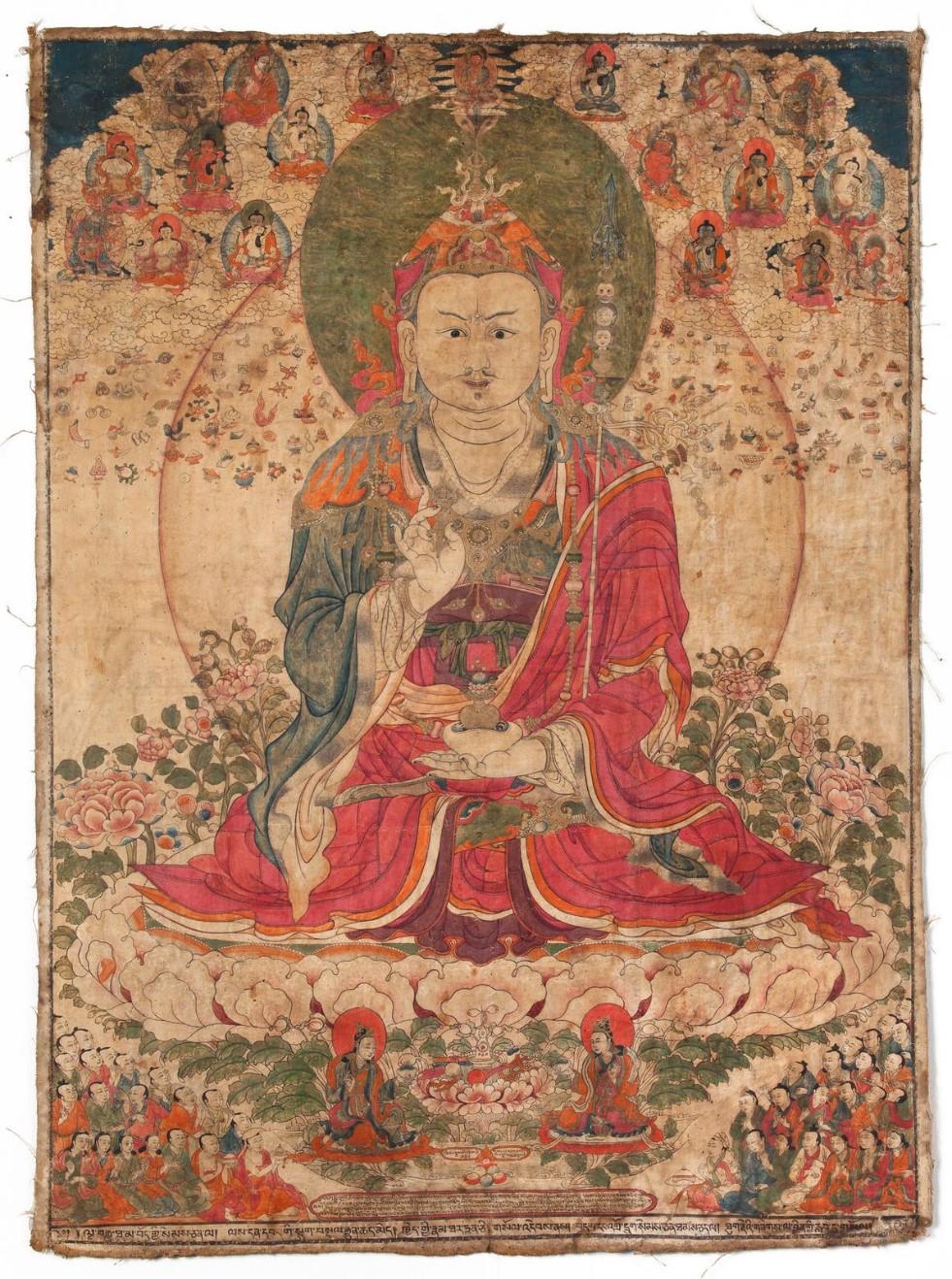Skidmore Faculty Scholar Residency
Co-Sponsored by the Center for Leadership, Teaching, and Learning and the Office of Special Programs
Artist Unknown (Tibet), Padmasambhava, 19th century, pigment on cloth, 28 ¼ x 20 inches, image courtesy Rubin Museum of Art
Skidmore Faculty Scholar-in-Residence
Benjamin Bogin, Associate Professor and Director of Asian Studies
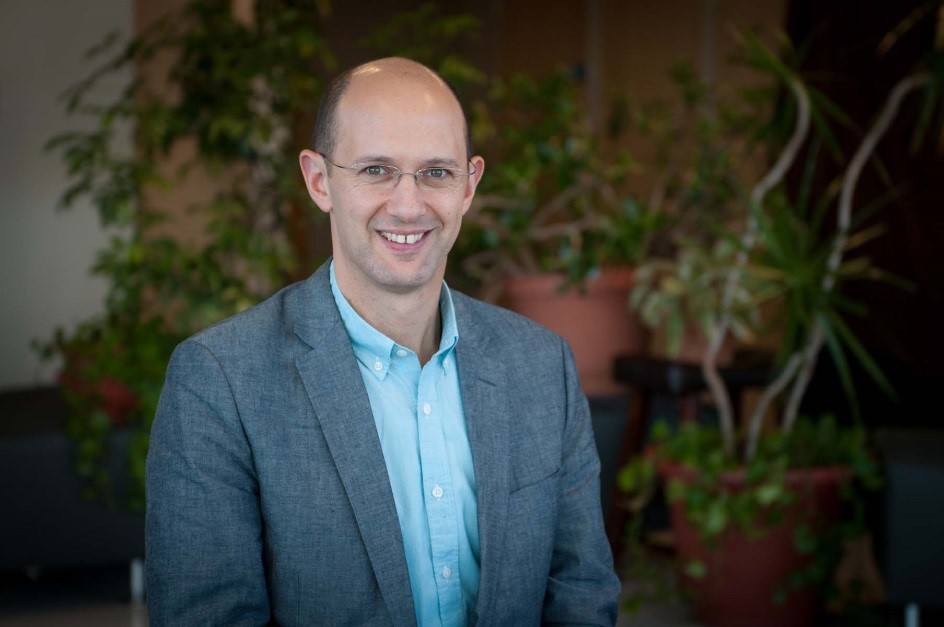
Photo by Megan Mumford Photography
Skidmore Faculty Scholar-in-Residence Benjamin Bogin, Associate Professor and Director of Asian Studies, has organized a range of events during the Spring 2019 semester to coincide with the Tang Teaching Museum’s "The Second Buddha,” an exhibition co-organized by the Rubin Museum of Art in New York and the Tang that focuses on Padmasambhava, the legendary Buddhist master credited with bringing Buddhism to Tibet. A host of scholars, artists, musicians, educators, and Tibetan Buddhist lamas will visit campus throughout the semester to offer class visits and public lectures exploring aspects of the exhibition.
Benjamin Bogin (PhD, Buddhist Studies, University of Michigan, 2005) is a scholar of Himalayan Buddhism. He is Associate Professor and Director of Asian Studies at Skidmore College. Bogin writes and teaches on the intersections of biographical literature, sacred geography, visual art, and ritual practice in Himalayan cultures. He is the author of The Illuminated Life of the Great Yolmowa (Serindia Publications, 2013) and the co‐editor, with Andrew Quintman, of Himalayan Passages: Tibetan and Newar Studies in Honor of Hubert Decleer (Wisdom Publications, 2014).
The Spring 2019 Skidmore Faculty Scholar Residency is co-sponsored by the Center for Leadership, Teaching, and Learning and the Office of Special Programs; and the Tang Teaching Museum.
Schedule of events
All events at The Tang Museum
Saturday, February 9 at 4:00 PM: The Second Buddha: Master of Time Curators' Tour & Spring Opening Reception — Rachel Seligman, Tang Assistant Director for Curatorial Affairs and Malloy Curator, Elena Pakhoutova, Rubin Museum Curator of Himalayan Art, and Benjamin Bogin, Skidmore Professor of Asian Studies, lead a tour of The Second Buddha: Master of Time, followed by an opening reception for all of the Tang’s exhibitions
Tuesday, February 12, Noon: Curators’ Tour of The Second Buddha: Master of Time — With Tang Assistant Director for Curatorial Affairs and Malloy Curator Rachel Seligman and Skidmore Professor of Asian Studies Ben Bogin
Tuesday, February 19 at 6:00 PM: An Artist’s View of the Second Buddha — Pema Namdol Thaye, a renowned Tibetan painter, discusses his perspective on Padmasambhava
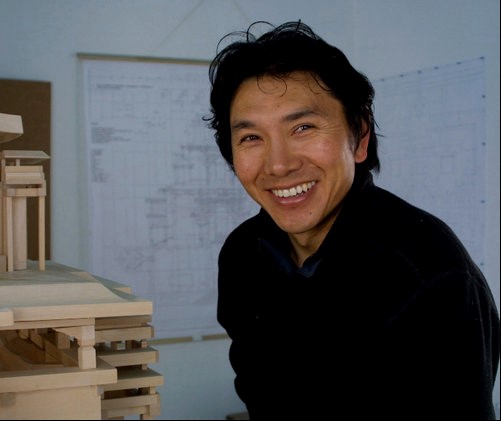 Pema Namdol Thaye is a painter, sculptor, 3-D mandala specialist, traditional Tibetan architect, author,
and art educator. He has won international acclaim as a master of traditional Himalayan
arts, and his “extraordinary ability in his field of expertise,” was recognized by
the U.S. government awarding him permanent residency in the USA in 2008. In the same
year Pema Namdol founded Padma Studios, a multidisciplinary fine art studio in Los
Angeles, California.
Pema Namdol Thaye is a painter, sculptor, 3-D mandala specialist, traditional Tibetan architect, author,
and art educator. He has won international acclaim as a master of traditional Himalayan
arts, and his “extraordinary ability in his field of expertise,” was recognized by
the U.S. government awarding him permanent residency in the USA in 2008. In the same
year Pema Namdol founded Padma Studios, a multidisciplinary fine art studio in Los
Angeles, California.
Thursday, February 21 at 6:00 PM: “Bringing the Past to Life: Visions, Writing, and Me” — Janet Gyatso, Harvard Professor of Buddhist Studies, reflects on reading and translating the visionary autobiography the 18th-century Tibetan Buddhist master, Jigme Lingpa
This talk will discuss the Tibetan art of writing autobiography and how the modern scholar herself becomes connected to it. It will focus on how Gyatso appreciated, translated, and wrote about the “secret autobiographies” of Jigme Lingpa, an 18th century visionary, who was himself trying to connect to the 8th century master Padmasambhava. It will reflect on how the speaker worked with Tibetan scholars to translate the text, and what “understanding” the work meant, both for her and for the Tibetan readers with whom she studied. Finally, it will talk about how the author of the autobiography used writing and vision to imagine himself.
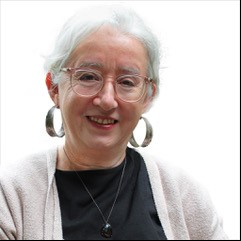 Janet Gyatso is a scholar in Buddhist studies with concentration on Tibet. Her books include a
study of Tibetan autobiography, and an intellectual history of medicine in early modern
Tibet. She has also been writing on memory; sex and gender; and on the current female
ordination movement in Buddhism. Her present research focuses on poetics, as well
as a project in animal studies. Gyatso was president of the International Association
of Tibetan Studies and co-chair of the Buddhism Section of the American Academy of
Religion. Gyatso is Harvard Divinity School's first Hershey Professor of Buddhist
Studies and is also currently the Associate Dean for Faculty and Academic Affairs.
Janet Gyatso is a scholar in Buddhist studies with concentration on Tibet. Her books include a
study of Tibetan autobiography, and an intellectual history of medicine in early modern
Tibet. She has also been writing on memory; sex and gender; and on the current female
ordination movement in Buddhism. Her present research focuses on poetics, as well
as a project in animal studies. Gyatso was president of the International Association
of Tibetan Studies and co-chair of the Buddhism Section of the American Academy of
Religion. Gyatso is Harvard Divinity School's first Hershey Professor of Buddhist
Studies and is also currently the Associate Dean for Faculty and Academic Affairs.
Wednesday, March 20 at 6:00 PM: Seeing Without Looking: a Psychoanalytic View of the Great Perfection Contemplation in Tibet — Jacob Dalton, Khyentse Chair of Tibetan Buddhist Studies at UC Berkeley, explores connections between psychoanalytic theory and Tibetan Buddhist meditation
Many agree that the Great Perfection (Dzogchen) tradition marks apogee of Tibetan Buddhist Contemplative theory and practice. With roots in the late eighth century and still popular today, its most creative teachings emerged in the eleventh to fourteenth centuries, inspiring the Tibetan Book of the Dead and countless other writings. Through extended periods of gazing at the sky or being immersed in darkness, its practitioners open their vision to "the marginal" and develop new ways of relating to their experiences. In this talk, Dalton draws on psychoanalytic writings, from Winnicott to Bion, André Green to Bollas, to try to understand how these remarkable contemplations might work to transform their practitioners.
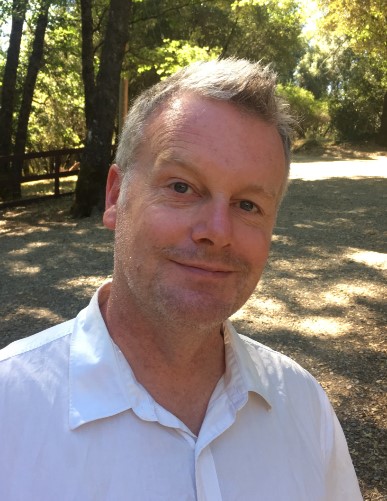 Jacob Dalton, Khyentse Foundation Distinguished University Professor in Tibetan Buddhism, holds
a joint appointment in South and Southeast Asian Studies and East Asian Languages
and Cultures at UC Berkeley. He works on tantric ritual, Nyingma religious history,
paleography, and the Dunhuang manuscripts. He is the author of The Taming of the Demons:
Violence and Liberation in Tibetan Buddhism (Yale University Press, 2011) and The
Gathering of Intentions: A History of a Tibetan Tantra (Columbia University Press,
2016). He is currently working on a study of tantric ritual in the Dunhuang manuscripts.
Jacob Dalton, Khyentse Foundation Distinguished University Professor in Tibetan Buddhism, holds
a joint appointment in South and Southeast Asian Studies and East Asian Languages
and Cultures at UC Berkeley. He works on tantric ritual, Nyingma religious history,
paleography, and the Dunhuang manuscripts. He is the author of The Taming of the Demons:
Violence and Liberation in Tibetan Buddhism (Yale University Press, 2011) and The
Gathering of Intentions: A History of a Tibetan Tantra (Columbia University Press,
2016). He is currently working on a study of tantric ritual in the Dunhuang manuscripts.
Tuesday, March 26 at 6:00 PM: Art about Art — Rob Linrothe, Northwestern University Professor of Art History, offers art historical observations on representations of art in The Second Buddha
Art about art
Although not distinctive to paintings of Padmasambhava or of the teachers who have preserved his legacy in Tibet, many of the works in the exhibition and catalog feature depictions of paintings, sculptures, ritual objects, and architecture. These are instances of “art about art,” and are a fascinating reward for close looking not only at the main figure or the overall composition, but details and what may appear to be relatively minor elements. This talk highlights some of the instances of this in the “The Second Buddha: Master of Time” exhibition, and explores the ways the art on view incorporates particular structures and forms of visual “supports” that were important in the transmission of Padmasambhava’s life, lore, and rituals.
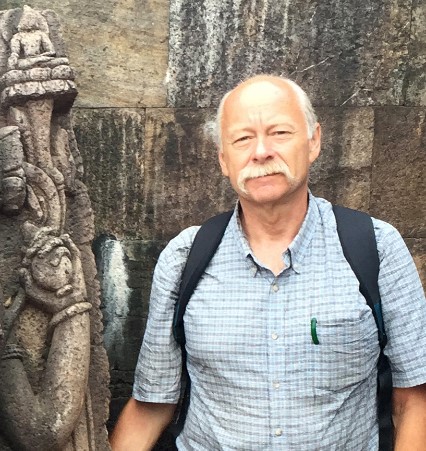 Rob Linrothe is Associate Professor and Chair of the Department of Art History at Northwestern
University, Evanston. His research is mainly based on fieldwork in Ladakh and Zangskar.
He earned a Ph. D. in Art History from the University of Chicago. In 2016–2017 Linrothe
received a Senior Fellowship from the American Institute of Indian Studies to do fieldwork
in eastern India on 8th to 13th century sculpture in Bihar, West Bengal and Odisha.
His recent books are Seeing Into Stone: Pre-Buddhist Petroglyphs and Zangskar’s Early
Inhabitants (2016); Visible Heritage: Essays on the Art and Architecture of Greater
Ladakh, ed. Rob Linrothe and Heinrich Pöll; and Collecting Paradise: Buddhist Art
of Kashmir and its Legacies (2015) (with contributions by Christian Luczanits and
Melissa Kerin). Other recent publications include: “Noise Along the Network: A Set
of Chinese Ming Embroidered Thangkas in the Indian Himalayas,” in Buddhist Encounters
and Identities Across East Asia (2018); “‘Utterly False, Utterly Undeniable’: The
Akaniṣṭha Shrine Murals of Takden Phuntsokling Monastery,” Archives of Asian Art (2017);
“Donor Figures on 9th–12th Century Sculpture in Eastern India: A Progress Report.”
Journal of Bengal Art 22 (2017); “Siddhas and Sociality: A Seventeenth-Century Lay
Illustrated Buddhist Manuscript in Kumik Village, Zangskar (A Preliminary Report)”
In Visible Heritage (2016); “Mirror Image: Deity and Donor as Vajrasattva” in History
of Religions (2014); and “Portraiture on the Periphery: Recognizing Changsem Sherab
Zangpo,” Archives of Asian Art (2013).
Rob Linrothe is Associate Professor and Chair of the Department of Art History at Northwestern
University, Evanston. His research is mainly based on fieldwork in Ladakh and Zangskar.
He earned a Ph. D. in Art History from the University of Chicago. In 2016–2017 Linrothe
received a Senior Fellowship from the American Institute of Indian Studies to do fieldwork
in eastern India on 8th to 13th century sculpture in Bihar, West Bengal and Odisha.
His recent books are Seeing Into Stone: Pre-Buddhist Petroglyphs and Zangskar’s Early
Inhabitants (2016); Visible Heritage: Essays on the Art and Architecture of Greater
Ladakh, ed. Rob Linrothe and Heinrich Pöll; and Collecting Paradise: Buddhist Art
of Kashmir and its Legacies (2015) (with contributions by Christian Luczanits and
Melissa Kerin). Other recent publications include: “Noise Along the Network: A Set
of Chinese Ming Embroidered Thangkas in the Indian Himalayas,” in Buddhist Encounters
and Identities Across East Asia (2018); “‘Utterly False, Utterly Undeniable’: The
Akaniṣṭha Shrine Murals of Takden Phuntsokling Monastery,” Archives of Asian Art (2017);
“Donor Figures on 9th–12th Century Sculpture in Eastern India: A Progress Report.”
Journal of Bengal Art 22 (2017); “Siddhas and Sociality: A Seventeenth-Century Lay
Illustrated Buddhist Manuscript in Kumik Village, Zangskar (A Preliminary Report)”
In Visible Heritage (2016); “Mirror Image: Deity and Donor as Vajrasattva” in History
of Religions (2014); and “Portraiture on the Periphery: Recognizing Changsem Sherab
Zangpo,” Archives of Asian Art (2013).
Monday, April 1 at 6:00 PM: Dream Images, Poetic Visions — Dominique Townsend, poet and Professor of Religious Studies at Bard College, gives a reading and discussion of Terdak Lingpa’s poetic dream yoga instructions
In this talk, Townsend will consider the relationship between poetic language and
liminal dream states through the work of Terdak Lingpa, the subject of a painting
displayed in the “Second Buddha” exhibition. Through translated excerpts of his brief
instructions for cultivating dream states as a way to recondition perception and become
liberated from the miserable cycle of rebirth, Townsend will reflect on the relationship
between brevity, ambiguity, and insight.The instructions appear quite ordinary on
the surface, but claim to provide the means for liberation in just one Tibetan page,
front and back. The brevity of the instructions works together with apophatic language
(using negation to approach the divine) and a reconciling of uncertainty to spark
full awakening through the very act of dreaming.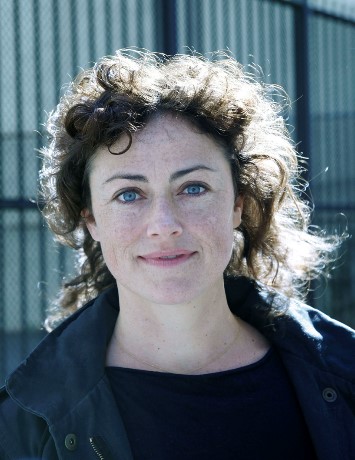
Dominique Townsend is Assistant Professor of Buddhist Studies at Bard College. Her research focuses on Buddhist aesthetics and cultural production. Her book A Buddhist Sensibility: Aesthetics and Cosmopolitanism in Early Modern Tibet is forthcoming from Columba University Press. Townsend's newest research project involves Tibetan poetics and the challenges of translation. She is also a poet—her first book of poems The Weather & Our Tempers was published by Brooklyn Arts Press.
Thursday, April 4 at 6:00 PM:
Lama Rod Owens on “Radical Presence and Social Justice” — Connecting the Second Buddha’s
teachings with contemporary concerns. 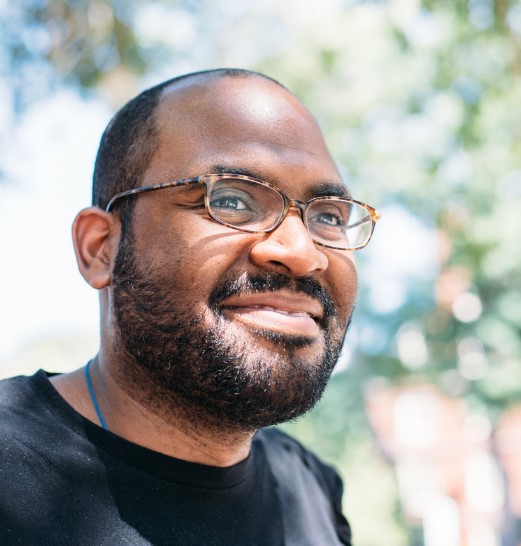
Perhaps the most radical act now is to be our most open and vulnerable selves allowing our broken hearts to be glimpsed. In this glimpsing, we can learn to allow our broken hearts with its fear, trauma, and ignorance to inform our social change work. Radical presence is the practice of allowing our broken hearts to show us how to be free and to help others to get free.
Lama Rod Owens is considered one of the emerging leaders of his generation of Buddhist teachers. An author, activist, and formally authorized Buddhist teacher in the Tibetan tradition of Buddhism, he is the co-founder of Bhumisparsha, a Buddhist tantric practice community as well as a visiting teacher with several Buddhist centers including the Natural Dharma Fellowship and the Brooklyn Zen Center. A graduate of Harvard Divinity School, Lama Rod has also been a guest faculty member at the Harvard School of Education’s program Mindfulness for Educators. He has been a regular guest on SiriusXM’s Urban Viewhosted by Pulitzer Prize winning journalist Karen Hunter. He is also a co-author of Radical Dharma: Talking Race, Love, and Liberationand his next book project exploring transformative anger and rage is due out Fall 2019. Lama Rod can be reached at www.lamarod.com.
Tuesday-Thursday, April 16-18, 6:00 PM each night: Bardo Now — This three-day series explores the Tibetan Buddhist concept of the bardo, most often understood as the intermediate space between death and rebirth (as described in the Tibetan Book of the Dead, attributed to Padmasambhava), in contemporary literature, art, and music. Highlights include a discussion of George Saunders’s novel Lincoln in the Bardo (April 16), a Dunkerley Dialogue with artist Laurie Anderson and Skidmore Professor of Asian Studies Ben Bogin (Wednesday, April 17), and a performance by guitarist Tashi Dorji and percussionist Susie Ibarra, who will perform an experimental duet conceived for this event as a musical bardo exploration (Thursday, April 18)
The Second Buddha: Master of Time is presented by the Rubin Museum of Art and the Tang Teaching Museum and Art Gallery at Skidmore College. The exhibition is curated by Rubin Museum Curator of Himalayan Art Elena Pakhoutova and organized for the Tang Museum by Assistant Director for Curatorial Affairs and Malloy Curator Rachel Seligman. Support for the exhibition is made possible in part by Bob and Lois Baylis, Barbara Bowman, Lisina M. Hoch, E. Rhodes and Leona B. Carpenter Foundation, Friends of the Tang, Andrew W. Mellon Foundation, the Ellen Bayard Weedon Foundation, and contributors to the Rubin Museum 2017 and 2018 Exhibitions Fund.
